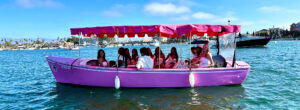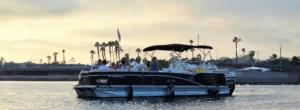Introduction
Embark on a serene journey through the vibrant marine ecosystem of Newport Beach, where the unique blend of calm waters and rich biodiversity creates an exceptional setting for wildlife spotting. Electric and pontoon boats, known for their quiet operation and steady navigation, offer the perfect platform for observing a variety of marine life in their natural habitats. This article explores the seasonal wildlife that can be seen from these boats, providing a guide to the most thrilling natural spectacles throughout the year.
Newport Beach’s coastal waters are a haven for wildlife enthusiasts, drawing visitors from all around to witness its natural beauty and diverse species. From playful dolphins in the summer to migrating whales in the winter, the opportunity to connect with nature is ever-present. These eco-friendly boats allow for close encounters without the disturbance often caused by louder, faster boats, making them ideal for those who seek a peaceful yet intimate experience with wildlife.
This guide not only highlights what wildlife you can expect to see during each season but also offers tips on how to responsibly enjoy these encounters. Whether you are a seasoned naturalist or a curious tourist, understanding the rhythms of nature here can enhance your appreciation and ensure a fulfilling experience on the water.
Overview of Newport Beach’s Marine Environment
Newport Beach is characterized by a complex marine ecosystem that supports an array of wildlife species. Its geographical location along the Pacific Flyway makes it a crucial stopover for migratory birds, while its waters are home to numerous species of fish, mammals, and invertebrates. The blend of sandy beaches, rocky coves, and estuarine environments contributes to the high biodiversity, making it a microcosm of California’s coastal ecology.
The area benefits from the mixing of warm waters from the south and cooler, nutrient-rich currents from the north, creating an ideal environment for both warm and cold-water species. This unique marine habitat supports everything from tiny plankton to large marine mammals, providing ample viewing opportunities throughout the year. The presence of protected areas and conscientious wildlife management practices help maintain the balance and ensure the sustainability of these natural resources.
For wildlife spotters, the varied environment means that each trip out onto the water can offer something new and exciting. The predictability of some species’ appearances does not diminish the thrill of spotting them, while the possibility of rare sightings adds an element of surprise to every excursion.
Benefits of Electric and Pontoon Boats for Wildlife Spotting
Electric and pontoon boats are particularly well-suited for wildlife spotting due to their minimal environmental impact. The quiet operation of electric motors ensures that animals are not startled, allowing closer approaches than would be possible with traditional motorboats. This stealthy approach is essential for observing natural behaviors without causing distress or disruption to wildlife.
Pontoon boats offer a stable and spacious viewing platform, ideal for groups of wildlife watchers. Their design minimizes the rocking and rolling common in other vessels, which not only makes for a comfortable ride but also aids in the use of binoculars and cameras, essential tools for any wildlife enthusiast. Additionally, the open design of these boats provides unobstructed views, ensuring that all on board have an equal opportunity to witness the wonders of nature.
Their eco-friendly nature and operational efficiency make these boats a favorite among conservationists and casual observers alike. By choosing such a mode of transportation, visitors not only enjoy a superior viewing experience but also contribute to the conservation efforts by reducing pollution and disturbance in these delicate ecosystems.
Spring Wildlife in Newport Beach
Spring in Newport Beach is a time of rejuvenation and vibrant activity in the marine world. The warming waters bring an abundance of life, kickstarting the annual cycle of growth and reproduction. During this season, visitors can expect to see a variety of bird species, including the elegant tern and the blue heron, as they return to the coast to nest. The marshes and wetlands are particularly active with avian life, as migratory birds stop to rest on their journey north.
Marine mammals also begin to make a more frequent appearance. Gray whales can often be seen migrating northwards with their calves, a majestic sight that draws spectators from around the world. Sea lions, too, are more visible as they bask in the warmer temperatures on buoys and docks, and their playful antics provide endless entertainment for observers.
For those interested in smaller creatures, the tide pools start to teem with life. Starfish, sea urchins, and various crustaceans are easily spotted during low tides, making spring a fantastic time for families and educational groups to explore the richness of tidal ecosystems. These months offer a symphony of life that is both a visual and educational treat for anyone venturing onto the water.
Summer Wildlife in Newport Beach
Summer in Newport Beach is perhaps the best time for spotting dolphins, which are commonly seen frolicking near the shore. Both bottlenose and Pacific white-sided dolphins are regular visitors, often delighting passengers by riding the bow waves of boats. This season also sees an increase in the sightings of blue and humpback whales, which come to feed on the abundant krill and small fish brought close to the surface by the warm summer currents.
Bird life continues to thrive, with pelicans and cormorants frequently spotted diving for fish. The summer also marks the breeding season for many bird species, so it’s not uncommon to see young chicks making their first ventures into the water. The increased activity provides a great opportunity for photographers and nature lovers to capture dynamic interactions in the wild.
Furthermore, the warmer waters accelerate the growth of marine plants, drawing a variety of herbivorous fish to the shallows. Snorkelers and glass-bottom boat passengers can enjoy vivid displays of underwater life, making every excursion a colorful and educational experience.
Autumn Wildlife in Newport Beach
As autumn arrives, the pace of life in Newport Beach’s waters begins to change. This season is marked by the southward migration of several whale species, providing another opportunity for spectacular sightings. The cooler waters also bring different species of fish closer to shore, attracting sport fishermen and curious spectators alike.
Bird watchers will find autumn particularly rewarding as many migratory species stop over during their southward journey. The marshes and estuaries fill with a variety of ducks, geese, and shorebirds, each with their own unique behaviors and interactions to observe. This time of year is excellent for educational outings, as the diversity of species provides a broad overview of bird life in the region.
The decreasing temperatures lead to less recreational traffic on the water, offering a more secluded and intimate experience for those venturing out. This quietude is perfect for those seeking a peaceful retreat into nature, as it allows for better listening opportunities and the chance to appreciate the subtle sounds of wildlife preparing for the coming winter.
Winter Wildlife in Newport Beach
Winter brings its own charms to the wildlife scene in Newport Beach. This is the prime season for spotting some of the larger marine mammals, including the impressive California gray whale during its migration. These gentle giants can often be seen breaching and spouting, providing an awe-inspiring display for fortunate observers.
The colder waters also attract seals and sea otters, which can be seen sunning themselves or frolicking in the surf. Their playful nature makes them favorite subjects for photography and observation, contributing to the joyful atmosphere of winter wildlife tours.
Additionally, the winter months see fewer tourists, allowing for a more tranquil and personal interaction with nature. The quiet waters and reduced boat traffic make it an ideal time for those seeking solitude and a deeper connection with the marine environment. Winter in Newport Beach offers a reflective retreat into the natural world, where the rhythm of life slows, and each sighting becomes a memorable encounter.</perspective
Tips for Responsible Wildlife Viewing
While enjoying the natural beauty of Newport Beach, it is crucial to observe wildlife responsibly to ensure minimal impact on their habitats and behaviors. Always maintain a respectful distance from all animals to avoid causing them stress or altering their natural activities. Use binoculars or zoom lenses to get a closer look without intruding on their space.
It is also important to follow all local guidelines and regulations regarding wildlife interaction. This includes adhering to speed limits to avoid startling or harming aquatic animals, especially in designated wildlife areas. Educating yourself and your group about the species you are likely to encounter can enhance your experience and foster a greater appreciation for the conservation efforts that protect these creatures.
Lastly, always leave the environment as you found it. This means disposing of all waste properly, keeping the waters clean for both the wildlife and other visitors. By practicing these responsible wildlife viewing techniques, you contribute to the sustainability of Newport Beach’s natural resources and ensure that future generations can also enjoy these wonderful experiences.
Best Spots for Wildlife Viewing in Newport Beach
For the best wildlife viewing experiences, several spots in Newport Beach are particularly renowned. The Newport Bay Conservancy offers guided boat tours that provide an in-depth look at the local ecosystems and are ideal for spotting a wide range of marine and bird life. The Upper Newport Bay Nature Preserve is another excellent area for observing seasonal migrations and is especially good for bird watching.
The waters around Balboa Island provide a scenic backdrop for spotting sea lions and dolphins, especially during the quieter morning hours. For those interested in whale watching, the open waters off the Newport Coast are your best bet during the migration seasons. Here, you can witness majestic whales as they journey along the Pacific coast.
Each of these locations offers unique viewing opportunities and environments, making them worth multiple visits throughout the year. Whether you choose to explore these areas via an organized tour or on your own with a rented electric or pontoon boat, you are sure to encounter fascinating wildlife and gain a deeper understanding of the rich biodiversity that Newport Beach has to offer.
Conclusion
Seasonal wildlife spotting from electric and pontoon boats in Newport Beach provides an enriching and sustainable way to connect with nature. Each season brings its own unique set of wildlife experiences, offering endless opportunities for discovery and enjoyment. By choosing eco-friendly electric or pontoon boats and practicing responsible viewing habits, visitors can enjoy the natural wonders of Newport Beach while contributing to the preservation of its vibrant ecosystems.
Whether you’re a seasoned naturalist or a casual observer, the wildlife of Newport Beach offers spectacular sights and memorable encounters that resonate long after the journey ends. So, grab your binoculars and set sail on an adventure that not only delights but also educates and inspires stewardship of our natural world.
Excited for an adventure with us or have a question? Call us at: (949) 675-8433 Book Your Ride with us: Click here to Book


